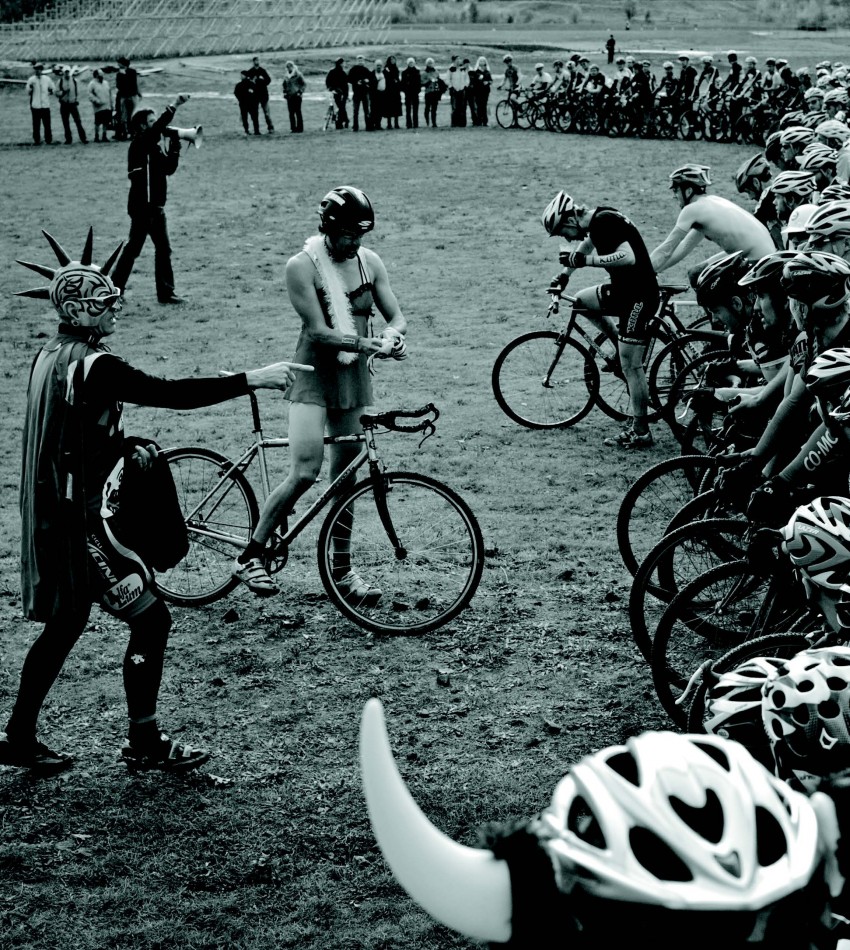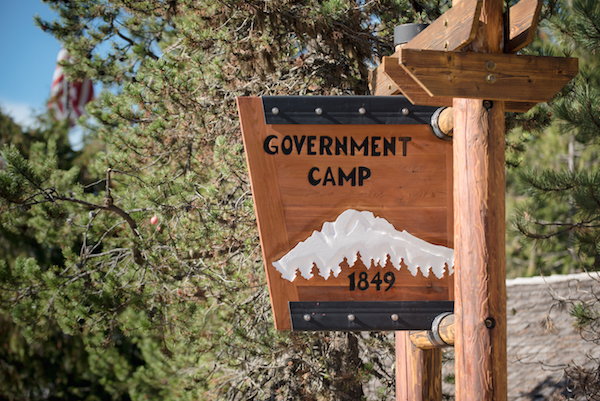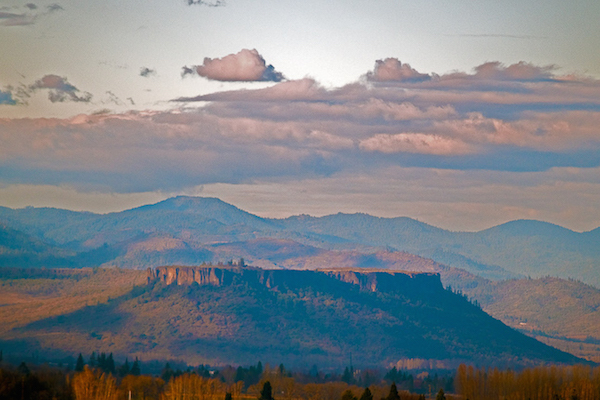written by Bob Woodward and Matthew Preusch
Pedaling through deep mud, sometimes over frozen snow-pack or dismounting to leap wooden barriers with bikes on their shoulders, riders in a growing cyclocross culture are creating an alternate reality for traditional cyclists and a custom mud-and-beer fit for Oregon.
“I’ll never forget my first national championships at Portland International Raceway,” pro cyclocross racer and Bend native Carl Decker recalls fondly. “The mud was hub-deep ooze, and I said to myself, ‘This is it: man against the elements.’ Then I got lapped by the lead group and realized, as tough as the conditions are, some people can really ride in it.”
Though the emerging Oregon phenomenon is relatively new, cyclocross, or cyclo-pedestre, began in France more than a century ago. French road racers, bored in the off season, started racing from town to town on dirt roads, through farmers’ fields and bogs, in pouring rain, driving sleet or snow. To keep their limbs from freezing during the race, riders would run up hills with their bikes and even dismount, bikes ashoulder to jump over obstacles. The rugged alter ego for road biking was born.
“There’s been a huge effort to make cross racing in Portland and elsewhere accessible to everyone, especially people doing their first race. So there’s no big deal about what kind of bike you ride or what you wear.”
— Brad Ross, Cross Crusade Director
Imported to the United States in the 1950s, cross remained the sport of few, inching slightly into cycling’s mainstream consciousness with the staging of the first national cross championships in Berkeley’s Tilden Park in 1975. A year later, the championships moved to Oregon’s Sunriver Resort south of Bend. Over the past few years, the sport has exploded in Oregon, creating courses from Pendleton to Portland and Astoria to Ashland, while nurturing many of the country’s top riders. Just a few in that tier include Decker; Ryan Trebon, 2006 USA Cyclocross National Champ; Adam Craig, 2008 U.S. National Mountain Bike Champion and U.S. Olympic team member; Vanilla team riders Shannon Skerritt and Molly Cameron; and Team River City Bicycles racers Wendy Williams and Sue Butler.
Though cross has its elite riders, it’s best known for its accessibility to riders of all flavors. In the Pacific Northwest, the Euro-inspired sport took on a Portland dialect: open-to-all, costumes appreciated, and beer and tequila gardens compulsory. Drinkers with a biking problem.
The Cross Crusade, a Portland-based race series, offers “beer primes” where racers draw a number before the race. If riders finish in a place with that number in it, they win a six-pack of beer. Last season the race series gave out thirty-five cases a week, recalls Brad Ross, Cross Crusade director and a serial race director for cross national championships. Part competition and part exhibition, Cross Crusade has grown to more than 950 racers last year from about a third of that in 2000, its inaugural year.
“Portland has the perfect chilly, rainy fall weather for cross racing,” notes Ross. “Beer seems to go hand in hand with cross racing. Perhaps it’s the fact that Portland is also the microbrewing capitol of the U.S. that makes the marriage so perfect.”
The versatility of its bikes has also led a small revolution in the hands of bike builders and on the floors of retailers. At Vanilla, a Portland-based custom cross bike builder, the waiting list is five years deep for a Sacha White-crafted bike.
Meanwhile Rich Slingsby, the buyer at Portland’s largest bike retailer, River City Bicycles, has seen sales soar recently. In 2003, River City carried four different cross models. Now the shop has 18 different cross models on the floor. Sales have gone from nothing a few years ago to account for nearly 10% of River City’s total bike sales.
“As far as bike racing goes, cyclocross has the least barriers to entry,” Slingsby says. “You could do it thirty minutes from your house, you don’t need all day to do it, and it’s not super intimidating like road racing, where you can get dropped by the peloton right away.”
At the smaller Bend Bike N Sport, owner Allen Lucas has seen similar trends. Two years ago, the Bend shop sold twenty cross bikes. Last year, that number just about doubled. “Probably the best thing is that it’s fun, and everyone is cheering you on,” says Lucas. “There are so many divisions going on at the same time in cross that you could be in last place and no one would know.”
The cross bike is similar to a road bike but differs in a few important ways. A cross bike costs much less, takes fatter wheels and knobby tires for rugged terrain; has a higher ground clearance to jump obstacles; and the brakes are widely set cantilevers.
“Road racing is more tactical: you are out racing longer, pacing and strategy are more important. With a cross race, you pretty much go as hard as you can and hope your bike and body stay in one piece for 45 minutes.”
— Sean Haidet, Bend cyclocross rider
But the bike itself may be one of the few similarities between cross culture and its much tidier road biking cousin, whose manners tend to straight lines, tactical teamwork and clean jerseys. Unlike most road races strung out over dozens of miles, the relationship between riders and fans tends to be much closer in smaller track cross races. “It’s like a homecoming game for bike nerds,” says Decker, 34, who has been racing bikes since he was 9 and is a member of the 2009 U.S. Mountain Bike Team and the 2008 Single-Speed Mountain Bike World Champion. “They get crazy and their energy is contagious. In the pack, there’s more of a sense of let’s have fun because this isn’t about making money.”
Decker recounts a 2007 cross race in Las Vegas, where spectators threw money onto the course to see who’d stop and pick it up. “It was a night race on a crap course, and my teammate, Adam Craig, and I got put in the back of the field because we hadn’t been racing much. We tried to move up as the race unfolded. But when we couldn’t make any progress, we started accepting pizza and beer from the spectators as we rode. Then Adam started picking up money. He made $53, and we both got reprimanded by the race organizer.”
Even team names reveal another schism between these pedal pushers. Road bike teams get corporate names like Bissell, Rabobank, Land Rover and Liquigas. Cross team names delve the essentials: Team Dirt, More Cowbells and Team Beer.
Team Beer rider Tony Pereira joined the communal mutton chops and spandex when he moved to Portland from Salt Lake City in 2005. The patron saint of Dirt Riders smiled on the Utah transplant as his new next door neighbor was pro cyclocross rider Molly Cameron. Pereira had been racing mountain bikes for years, and Cameron persuaded him to sign up for the upcoming cross race at Alpenrose Dairy in southwest Portland.
“I went out to it, and it was pouring rain,” says Pereira. “I bought some cross tires for my mountain bike, and I had a great time right off the bat.”
He also burned his lungs up so badly that first race he coughed for days, a cycling condition known as “track hack.” Hack or not, he was hooked.
Much like Pereira’s hacking introduction, Margi Lifsey, sustainability director for the Oregon Department of Transportation, had her own demons. “At my first race, I was so nervous I thought I was going to puke,” Lifsey says. She had already been bike commuting for a decade when she signed up to do her first cross race three years ago at Rainier High School on her modified Trek mountain bike. She remembers Ron Strasser, a veteran racer she had just met, running beside her during the race, ringing a cowbell and cheering her on.
“I didn’t puke. I have yet to puke, but that never goes away.”
How Cyclocross Works
Cross races are run on dirt, in mud, over hard-pack, on grass, down country lanes and through sand. Racers use either modified mountain bikes or cross bikes, which are essentially road bikes with more hefty tires for solid grip.
Riders race in male and female categories from elite to beginner with age groups in between.
Race courses are typically 10 feet wide (for passing ease) and 1-2 miles in length. A typical course will be designed to take in every type of terrain from hills to swales and flats.Courses are required to be at least 90% ride-able, and race distances can vary as organizers might shorten an event if the course is deemed to be barely ride-able. On most courses, race organizers break up the riding with sets of 15 inches high wood barriers. Normally, riders will dismount and carry their bikes while they hop over the barriers. If the barriers are set far enough apart, good riders are able to stay on their bikes and “bunny hop” over the barriers.
Top level elite riders will race laps for up to an hour. Those racing at the amateur level will race for shorter periods of 30-45 minutes.
Because of the extreme terrain of cyclocross courses, racers are allowed to have pit crews who can make quick mechanical repairs to an ailing bike or swap it out for a fresh one.
The Bike
From 20 feet away, a typical cross racing bike lookds much like a road racing bike. Get up close, and you see the differences.
– Wider tires than road bikes for terrain
– More fork clearance to accomodate wider tires and inevitable mud
– Slightly higher bottom brackets also for clearance
– Lower gearing overall or a simpler single chain-ring in front/10-gear rear cluster configuration
– Price is a fraction of road bikes
– Mutton chops (optional)
History of Cross
Early 1900s: During their off -season, French bike racers start informal town-to-town races that include riding on dirt roads, through bogs, and across farmers’ fields.
1902: Frenchman Daniel Gousseau creates the first official cross race which also serves as the French National Championship.
1910: Belgium stages a cross national championship. Switzerland follows with its own in 1912, and Luxembourg holds its first championship in 1923.
1924: Paris has the first international race (Le Criterium International de Cross-Country Cyclo-Pedestre).
1929: Spain holds a national championship and, a year later, Italy has its own.
1940: Professional cycling’s governing group, Le Union Cycliste International, recognizes cross as a competitive form of cycling.
1950: The first World Championships are staged in Paris.
1974: Although it’s been stateside for more than twenty years, cross racing starts to gain acceptance in the U.S. when races are run in New England.
1975: The first U.S. National Championships are staged in Tilden Park in Berkeley, California.
1976: Sunriver, Oregon hosts the U.S. National Championships with 120 competitors.
1993: Portlanders Rick Potestio and Russ Humbertson start the Cross Crusade Race series.
Late 1990s: Cross racing in American starts to gain in popularity with the Pacific Northwest the hotbed of interest.
2000: 350 racers compete in the first Cross Crusade series.
2003-04: The U.S National Championships are held in Portland, with 2,000 competitors.
2008: 950 racers compete in the Cross Crusade series.
2009: The U.S. National Championships are held in Bend, Oregon with 2,500 expected riders.
“The mud was hub-deep ooze, and I said to myself, ‘This is it: man against the elements.”
Carl Decker
Age: 34
Bike: Giant
Years racing: 25
Post-race routine: Beer and talking the race over with friends
Tattoo: Decker has the “trophy” for becoming the Single Speed World Champion (SSWC) in 2008.
“There are races where there are technical sections that have rocks and roots on the trail. That’s my favorite part, where I can pick up some time on the roadies.”
Tony Pereira
Age: 40
Bike: Pereira Cycles Downtown Brown Custom single-speed
Years racing: 5
Post-race routine: Beer and a SunShower
“I didn’t puke. I have yet to puke, but that never goes away.”
Margi Lifsey
Age: 35
Bike: Kona Jake the Snake
Years Racing: 3
Post-Race Routine: Towel off mud in time to watch her fiance race









